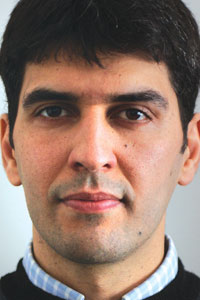Ehsan Arabzadeh

University of New South Wales, Australia
http://www2.psy.unsw.edu.au/Users/earabzadeh/
What does your research focus on?
A principal challenge of systems neuroscience is to quantify brain activity underlying behavior. Key questions include: How are different stimuli represented in neuronal activity? How does neuronal activity give rise to animals’ choices? I have a broad interest in systems neuroscience spanning areas such as sensory coding, adaptation, and learning. In the lab, we perform neuronal recording from cortex and deep-brain structures in anesthetized as well as awake behaving rats, and apply computational methods to quantify the way in which single neurons or neuronal ensembles code for sensory stimuli, the animal’s choice, and the outcome of a behavioral action.
One focus is the rat whisker sensory system. The detailed knowledge of cortical processing circuitry, combined with the animals’ high-level sensory capacities, makes this system an ideal platform for studying the neuronal bases of behavior.
What drew you to this line of research? Why is it exciting to you?
I studied medicine at Tehran University intending to practice, but I soon became interested in research. Neuroscience was the field that appealed to me most, particularly the study of higher functions in relation to cellular activity. In a small group of medical students, we read and discussed neuroscience papers with fascination. My interest in neural coding became more focused and grew in time during my PhD years at The International School for Advanced Studies (SISSA), Trieste, Italy. I believe what drew me to this research was a simple desire to know how the brain works. Most exciting is the inspection of neuronal activity — either by listening to a single neuron fire in response to sensory stimuli or by looking at neuronal ensemble activity using in vivo imaging techniques. Knowing that I am encountering the physical substrate for a perceptual experience is quite a thrill.
Who were/are your mentors or psychological influences?
Mathew E. Diamond — it has been a great pleasure and inspiration having him as my PhD advisor. These days, I often find myself in the middle of an intense discussion with Fred Westbrook on some detailed aspect of learning theory.
To what do you attribute your success in the science?
My father, a chemist, taught me patience and attention to detail, and my mother, a medical doctor, showed me how to care and be passionate about my work.
What’s your future research agenda?
In recent years, there has been considerable progress in understanding the neuronal mechanisms that underlie sensory representations. However, much less is known about how animals integrate sensory information to make decisions in an uncertain and often changing environment. In the lab, we aim to build on our detailed knowledge of an expert sensory system, the rat whisker sensory system, and investigate the neuronal underpinnings of choices and behavior.
Any advice for even younger psychological scientists? What would you tell someone just now entering graduate school or getting their PhD?
My observation is that not enough attention is given to brain structure and function. Neuroscience is close to being able to ground some psychological processes in neural mechanisms. As such it offers young psychological scientists a real prospect to contribute to understanding nature’s most complex physical object — the brain. As a graduate student I myself enjoyed learning anatomy and physiology which proved invaluable for sharpening my research questions and approach.
What publication are you most proud of or feel has been most important to your career?
Arabzadeh E, Zorzin E, & Diamond ME (2005). Neuronal encoding of texture in the whisker pathway. PLoS Biology, 3(1), e17.
This research constituted the first demonstration of coding of naturalistic stimuli in rat whisker systems. The paper demonstrated that as a whisker moves along a given textured surface, there is a “signature” of whisker vibration unique to that surface; driven by whisker vibration, receptor and cortical cells produce remarkably precise trains of spikes. These spike sequences, unique to each texture, are the words that form the neuronal language of texture sensation. This paper triggered a surge in interest and rapid progress in the field, and I was pleased that it received 100 citations in the first five years after its publication.





APS regularly opens certain online articles for discussion on our website. Effective February 2021, you must be a logged-in APS member to post comments. By posting a comment, you agree to our Community Guidelines and the display of your profile information, including your name and affiliation. Any opinions, findings, conclusions, or recommendations present in article comments are those of the writers and do not necessarily reflect the views of APS or the article’s author. For more information, please see our Community Guidelines.
Please login with your APS account to comment.